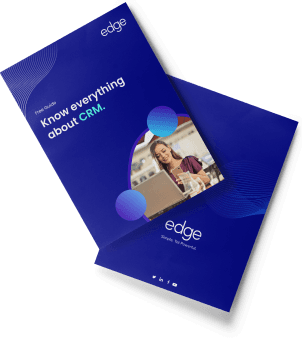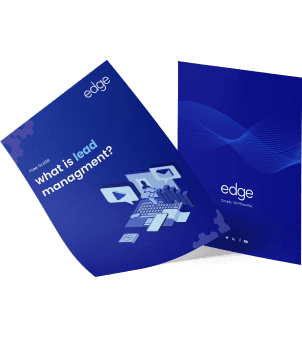Tring... Tring…Tring… *Phone rings*
“Hello, sir. I am calling from XXXX company. We have come up with XXXX this excellent and superior product. Would you like to try the same, sir?”
“No, I don’t require it at this time. Thanks.” *Call ends*
If almost all of your sales calls are ending this way, then it’s high time that you must rethink your sales prospecting strategy. Let’s see that in more detail.
What are those two factors around which the sales process always revolves?
Think…
Think…
Think…
Stop scratching your head! Here you go!
The sales process always revolves around two factors – Figures (numbers) and time!
You must achieve your sales target in a given deadline else you’re not a good sales executive, isn’t it? The sales process is a highly time-bound process, and one must keep that in mind all the time!
So, considering all the timing constraints, what is an essential and immediate step to be taken while planning your sales process? Any guesses?
Yes, you’re correct! It’s a Sales Prospecting!
In this 21st century, the sales process has become more and more customer-centric, and sales representatives must think out of the box to make plans successful.
They must develop their hacks, techniques, and smart-ways to process the prospecting.
What is Prospecting?
Well, prospecting is the process of developing any business by searching for potential customers (often called “Leads”) or buyers for your products or services.
The ultimate goal of the sales prospecting process is to move these prospects or leads through the result-oriented sales funnel until they are converted into revenue-generating loyal customers.
What is the goal of Sales Prospecting?
The main objective of the Sales Prospecting should be creating interest in your products or services and then convert that interest into a sales meeting, which ultimately results in closing the deal.
Is there any difference between Leads and Prospects?
Most often, these two terms are used interchangeably. However, as per some industry experts, there is a substantial difference between Leads and Prospects. Let’s understand the difference in detail.
Leads are the potential customers who have simply expressed interest in your product or service. Leads generally visit or subscribe to your website, blog, or landing page. They may download an ebook you’re distributing freely. So, basically, they are yet to engage in the primary sales cycle, and there is merely any kind of communication between them and the sales representative.
Prospects are nothing but the leads who are having two-way communication with the sales representative and may end up closing the deal.
Now that we have seen the meaning of sales prospecting, let us now check the necessity of the sales prospecting process.
Why is Sales Prospecting needed?
As per the report of the RAIN Group Center for Sales Research, approx. 71% of customers want to talk to sales representatives when they are looking to improve their business. Also, 62% of customers want to have immediate interaction with the sales team when they’re striving hard to solve their problems.
Well, this is one of the biggest reasons to recognize why Sales Prospecting is needed. Many customers are waiting to have an interaction with the sales team. It only takes the right techniques to reach your target customer and help them!
Now the question arises, how should one reach out to their prospects? Let’s see some other interesting stats that may help you.
Eight out of ten customers prefer contacting the sales team via emails, and almost 50% of the customers with higher designations like speaking on the phone rather than emailing. This underlines the importance of cold Calling when you’re targeting any CEO or similar higher management person.
The report of the RAIN Group Center for Sales Research has revealed some interesting insights. Per their report, the sales team must use the social media platform to reach their prospects. Their survey showed that 21% of prospects shown interest in interaction on LinkedIn, 21% of customers preferred text and voicemail for communication, 18% of people told that they would like any online social media platform. Interestingly, 34% of people said that they generally love interacting with the sales team in an industrial event.
There is one another popular term, which is common in the sales industry – “Opportunity.” Let us understand this term in detail.
Opportunity can be simply termed as “strong lead.” Opportunity (can be a firm or an individual) is a sales lead that has a high possibility and strong buying power than a sales lead to buy your product or service. In terms of need, opportunity possesses a more definite need for product or service, and it might have already dismissed the current supplier for product or service in search of new suppliers.
Difference between Opportunity and Lead
The main difference between and lead and opportunity is, the laTter has more chances to get converted into a firm and loyal customer. Hence, the sales team should always strive hard to convert leads into opportunities, and their probability of closing a deal will increase.
Practically, the sales team will have a number of leads in their list but only select opportunities. This is a common scenario, and there is nothing to worry about it. The only thing any sales team should keep in mind is, the opportunity they convert should be a premium quality lead, so that team never has to regret later. In terms of time and money also, its beneficial.
The Sales Funnel
Now, we have reached the crux of this article. The Sales Funnel is nothing but an ordered and systematic process of converting leads into prospects, opportunity, and then guaranteed customers. Let us understand the steps of the Sales Funnel. (Source: https://blog.hubspot.com/sales/prospecting)
Research
Goal: Determining the quality of lead
The sales team should first determine the criteria to calculate the probability of converting a lead or prospect into a regular customer.
Many companies use CRMs to keep track of their potential and existing customers.
Prospect
Goal: Connecting with leads to convert them into prospects
The second and crucial phase in the Sales Funnel. The team should keep an eye on every aspect they have noticed from the conversation with potential leads.
This helps them reach quality leads, which are nothing but prospects.
Connect
Goal: Connecting with the prospects
Now that the sales team has recognized the prospects, its time to connect with them.
The first call any sales representative makes with a prospect is called “Discovery Call.” This call decides whether to qualify this prospect for the next step in the Sales Funnel.
A sales team must make as many discovery calls as possible to connect with more opportunities.
Educate and Evaluate
Goal: Evaluating qualifying needs of a prospect
In this phase, a sales representative must recognize the prospect’s business needs. This will help them provide appropriate value to the prospect and shift to the next phase in the Sales Funnel.
Well, there is a big challenge you may have to face. If the prospect’s needs are contradicting the policies of your product or service, then you must be able to handle the situation.
Close the deal
Goal: Turn opportunities into regular customers
Despite facing the challenges, If you cross the fourth phase successfully, then congrats! You are really near to close the deal!
There are two types of deal closings you’ll come across in this phase, viz., Closed-won deal and Closed-lost deal.
The closed-won deal is the one when a customer purchases a product or service from the sales representative.
The closed-lost contract or agreement is the one in which the buyer does not buy anything from the salesperson.
This is the last phase in the Sales Funnel, and a salesperson must maintain a high closing ratio to lead in this era of competition.
So folks, now we’ve understood what sales prospecting is, the necessity of sales prospecting, the functioning of the Sales Funnel.
Are you ready to learn the next topic? Let’s go!
Sales Prospecting Techniques
As time progresses, sales prospecting techniques are also getting revolutionized. These techniques are widely classified as “Inbound Prospecting” and “Outbound Prospecting.”
Currently, as the situation demands, a sales representative should be in a position to implement either of the techniques and also switch in between them as per the requirement.
So, are you ready to learn the fundamental differences between each of the methods?
Outbound Prospecting
Well, Outbound Prospecting comprises one of the most common and traditional methods, which is used by almost every salesperson. Yes, you guessed it right, it’s “Cold Calling.”
Cold Calling is an irritating procedure of making unsolicited calls to sell your product or service. Almost all customers hate frequent sales calls, and this impacts negatively.
“Social Spamming” is one of the important aspects of outbound prospecting. It is becoming more popular nowadays and used by several sales representatives.
We do not recommend Social Spamming.
Because of the Cold Calling and Social Spamming, the Outbound Prospecting makes a very lesser context of any lead available to us; hence, it becomes difficult to establish a connection with lead or prospect.
Inbound Prospecting
Now, let us see what the Inbound Prospecting technique is all about.
Unlike Outbound Prospecting, this method includes sending warm emails to explore a good and healthy relationship with a lead. The lead or prospect could be a person who has already expressed interest in your product or service. So, frequent calling is avoided here.
Secondly, social media is also wisely used in this method. Just like warm mails, the salesperson can send their leads nice and short messages or media such as marketing videos or audio-visuals of your product or services. The sales team can also solve queries/issues asked by their customers on the social media platform. The social media platform can prove to be a very beneficial and emphatic image building tool for your organization.
Last but not least, inbound prospecting gives us many leads with concrete and firm contexts. Hence, we need to do very little research while establishing a connection with them! This saves you time and money that you can invest somewhere else and achieve even more perks!
Now, we’ve come to the end of this guide article.
Let us have a sneak peek on some of the interesting tips that every salesperson should follow for better sales prospecting.
Create an ideal prospect profile for yourself
Who else understands your business better than you, isn’t it?
So, create an ideal prospect profile for yourself and search in that direction.
Per one news study, as good as half of your prospects (50%) is not a good fit for what product/service you’re selling. I hope now you’ve understood how significant it is to create your ideal prospect profile.
Identify the right ways to communicate with your prospect
Start from the place where you met your prospect. It could be any industrial event or email or even on social media.
You may ask the prospect his/her convenient media to talk to. Always prefer their convenience over yours.
This will make them more comfortable with you and might result in closing a lovely deal for you!
Proactively work on your call lists
Remember, Cold Calling gives lesser results. Still, one should not underestimate the power of phone calls if optimized correctly!
You must make three types of call lists for you – cold call list, warm lead list, and even a lost lead list.
Per one latest research, 69% of leads accepted a call from new salespeople in the last 12 months. Also, 27% of salespeople admit that calling a lead/prospect along with your sales pitch is extremely useful.
Ask for referrals!
Well, this is a free-of-cost opportunity for any sales representative that he/she cannot afford to lose!
Asking your existing customers for referrals has proved to be a successful, tried, and tested formula to increase your customer base!
Per the researchers, the referral-based sales closing ratio stands as high as 50% - 70%! Isn’t it really astonishing?
Send relevant content to your prospect
If you want your potential customer to pay attention to you, then you must send him the content that is relevant to his needs.
“Personalized Mailers” could possibly be the best option we have available with us today. Remember, catching hold of the customer’s eye is your prime motive.
Demonstrate yourself in the video!
A picture speaks a thousand words, and a good, effective video speaks a million words!
This is the era where the attention span of people has reduced drastically.
Keeping this thing in mind, if you create a small, precise, informative, and promotional video of your product/service, then you can surely hit the bull’s eye!
Follow up, follow up, and follow up!
The success mantra to close any deal is “Follow Up, Follow Up and Follow Up” till the end!
The latest research says that if you’ve not heard back on your email from your customer in the last 24 hours, then it’s a time to follow up. There are 21% chances of getting a reply to your second mail.
So, we have reached the end of this guide. I hope this guide will prove to be useful to you in your sales process journey.
Especially in the current Corona Pandemic Outbreak scenario, do let us know what different tactics you’re using in sales prospecting.
Feel free to share your experience in the comments section below.












